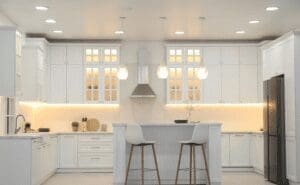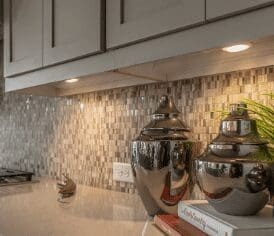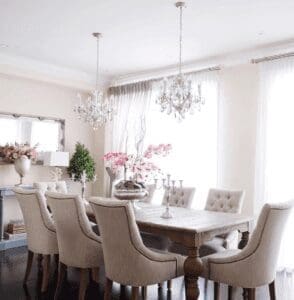
Choosing Ideal Lighting
For your kitchen, you’ll want it to be as bright as possible. The key to great kitchen lighting is to have a full cast of lighting sources and to “layer” your lights. Mix ambient, task, and accent, or decorative lighting with natural light. You’ll want to add 3 layers of light.

“Ambient” is your ceiling light that illuminates the entire room. “Task” is pendants over the island and undercabinet/counter lighting, and “accent lighting”.
Ambient lighting can come from recessed or can lights. These should be set a 24 – 42 inches apart. Be sure to light up your entire room with these and then add your pendants and access lighting.
Pendant lights allow you to set the tone for your room. Over an island you may choose to do 3 pendants, or maybe 5 smaller pendants. You’ll want your 3 pendants to have a 6-inch puddle of light and your smaller ones to have a 2-inch puddle.
Over an island you may choose to do 3 pendants, or maybe 5 smaller pendants. You’ll want your 3 pendants to have a 6-inch puddle of light and your smaller ones to have a 2-inch puddle.
Accent lighting focuses light on a particular area or object. It is often used to highlight art, etc. Common types of accent lights include wall sconces.
Recessed undercabinet lighting can help with dishwashing duties and create subtle mood lighting in architectural coves or areas with accent tilework. Adjust the color and intensity to create a mood. Puck or recessed mini can lights also bring sparkle underneath and to the interiors of cabinets. New easy-to-install puck lights are available with LEDs, which use much less electricity to produce light, last much longer, and produce less heat.
Lighting manufacturers have made it easier than ever to replace energy-hogging fixtures and bulbs for ones that last longer and trim utility bills. When you’re looking for lighting, simply look for products with the Energy Star label. Old lighting fixtures can quickly date a space. Replacing old chandeliers and flush-mount lights with fresh models can take years off your home’s looks.
Remember, the key to a brighter kitchen is more light. Dark surfaces and cabinets absorb light and white and light color surfaces do not. A kitchen with dark surfaces needs to have about 1/3 more light in it than a kitchen with lighter surfaces.
For your dining room table lighting,

you’ll want something eye catching like a chandelier. The rule of thumb for a chandelier is to keep the bottom of the chandelier at about 30 inches from the top of your table.
What about the eat-in kitchen? Be sure your lighting shape matches your table. For example, if you have a round table, choose something with a circular design rather than something rectangular.
TV-focused spaces need less overhead light and more ambient and task lighting, such as lamps.